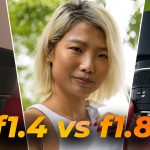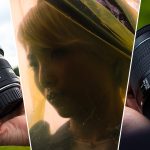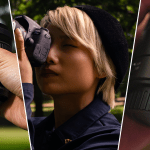In this review, we’re going to compare two relatively affordable lenses, the Canon EF 50mm f1.8, and the Canon EF-S 18-55mm kit lens. I’ll tell you what these lenses are good for, and we’ll talk about the issues that they both have.

Aperture & Focal Length
First off, let’s start with aperture and focal length. In terms of aperture, the 50mm f1.8 lens opens up to f1.8, while the 18-55mm lens opens up to f/3.5 when zoomed all the way out, and f/5.6 when zoomed all the way in. When you set your aperture to be as wide as possible, as you zoom in, you’ll notice that the lens will force it to close a bit.
Now, in terms of aperture, the EF 50mm f1.8 lens clearly wins, as it opens the widest, and thus it allows in more light. This is crucial when working in low-light conditions, as its wider aperture will allow you to get cleaner images.
In terms of focal length, the 50mm lens is indeed stuck at 50mm, whilst the 18-55mm lens can vary its focal length. What the 18-55mm bit means is that, as you zoom in and out, the focal length changes.
For example, when you’re zoomed all the way out, so you can see more in frame, you’re at 18mm. As you slowly zoom in, your focal length will go up, until you reach the maximum, at which point you’ll be at 55mm.
There is no clear winner in this regard, as there are pros and cons to this. You see, a lens with a fixed focal length, despite limiting you, also tends to produce sharper images. On the other hand, a lens like the 18-55mm kit lens allows you to get a variety of different shots. This is especially useful when learning photography and videography.
Ok, now, how portable are they?
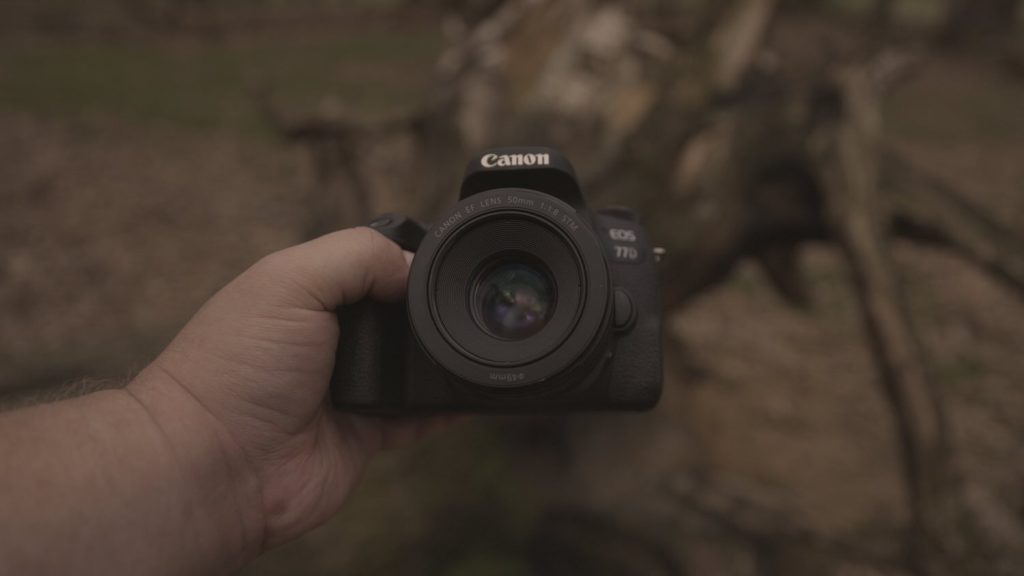
Size & Build
So, both of these lenses are relatively compact, which is great when you’re walking around and taking photos. The EF 50mm f1.8 lens measures 69.2 x 39.3mm, or 2.7 x 1.6″, and weighs in at 160g, or 5.7oz.
On the other hand, the Canon EF-S 18-55mm kit lens measures 66.5 x 61.8mm, or 2.6 x 2.4″, and weighs in at 215g, or 7.6oz.
The 50mm lens is thus smaller, but obviously the 18-55mm lens needs room for a zoom ring, and other internal components. Neither of them is particularly large though.
How about build quality? They’re relatively similar, and unfortunately rather plasticky. They’re durable enough if you take relatively good care of them though. Also, the EF 50mm f1.8 does have a metal mount, which is really appreciated.

Image Quality
Ok, so we’ve covered versatility and portability. Now, let’s say you’re about to head out the door to take some photos. What should you expect in terms of image quality?
Minimum Focusing Distance
So, the first thing that I want to look at is minimum focusing distance, as you’re likely to run into this issue, and it will confuse you at first.
Let’s say that you’re taking a photo of a flower. Ok, it looks cool, but you want to get closer. At some point, you’ll get so close, that focusing won’t work anymore. This is because every lens has a minimum focusing distance. In other words, if you’re too close, the lens won’t be able to focus.
In the case of the EF 50mm f1.8 lens, you need to be at least 35cm, or 1.15ft away from the subject. With the EF-S 18-55mm kit lens, you need to be 25cm, or 0.82ft away.
If you get closer than this, focusing just won’t work, so keep that in mind.
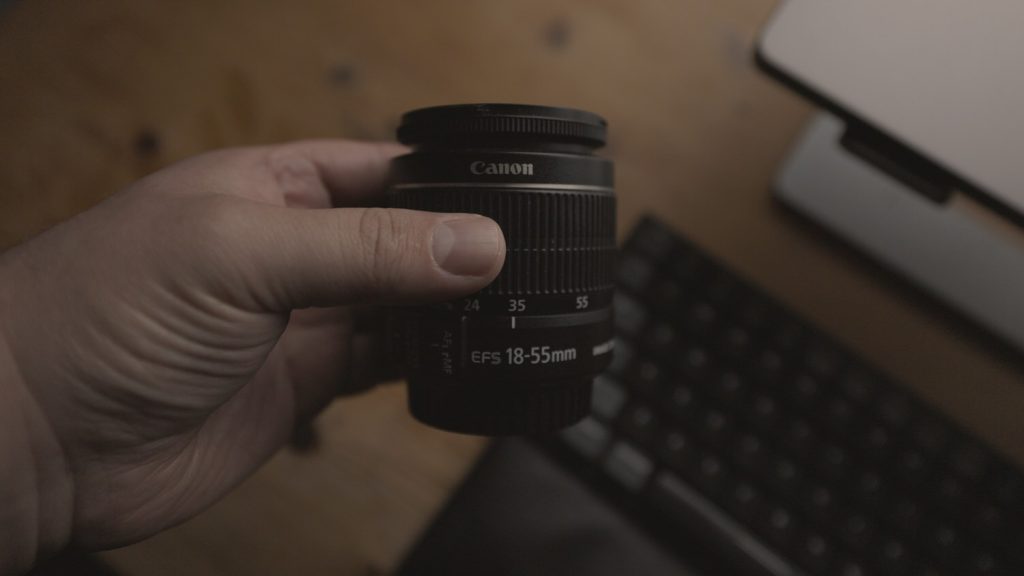
Sharpness
Right, what’s next? That’d be sharpness. Now, we’ve already discussed earlier which lens takes sharper photos, but there’s also another element to it. Most budget cameras aren’t evenly sharp across the frame.
In the case of both of these lenses, they’re sharper in the centre than they are on the edges of the frame. I don’t find this to be a problem, as your subject is usually going to be in the centre, and even so, most people don’t zoom in on the edges in order to find tiny flaws like that.
Vignetting
What about vignetting? So if you look closely at some photos, you’ll notice that the corners of the images are somewhat darker than the rest of the frame. This is vignetting, and it is technically an issue.

Again, most people won’t pick up on that, and in the case of portraits, I really like vignetting, as it adds depth to the image, and it naturally guides the eye to the subject’s face.
Chromatic Aberration
Next up, another optical issue would be chromatic aberration, which both of these lenses can exhibit under the right, or, I guess, wrong, conditions. So when taking photos in the evening, chromatic aberration can occur around straight lines in your photos. It usually looks like a magenta, blue, and greenish bleed around the edges of those straight lines.
It is technically an optical defect, but again, the vast majority of people will never notice, and in some cases, some chromatic aberration can actually add character to an image.
Image Stabilisation
Next up, what about image stabilisation? Does either of these lenses offer it? Yeah, the 18-55mm kit lens does, but the 50mm lens does not. So the kit lens has optical stabilisation built-in, which makes your shots less shaky. That’s a pretty useful feature, given that budget, or even mid-range cameras do not have built-in image stabilisation.

Autofocus
What about autofocus? The 50mm f1.8 lens has a stepping motor, hence the STM in the name, which provides smoother and quieter autofocus, especially when shooting video.
When it comes to video overall, if you’ll be filming handheld, the 18-55mm kit lens wins, due to its IS. If you’ll have the camera on a tripod though, the EF 50mm f1.8 wins, as it can provide you with that magical blurry background.
Compatibility
Next up, which cameras are these lenses compatible with? The clue lies in the name of each lens. The Canon EF 50mm f1.8 is compatible with both Canon EF and EF/EF-S cameras. This makes up the majority of Canon DSLRs.
What about the EF-S 18-55mm kit lens? Due to its mount, it will not work on full-frame cameras, like the Canon 6D, for example. The mounts are incompatible, you won’t even be able to install them on the camera. The EF-S 18-55mm is basically intended for the more affordable cameras in the Canon range.
Vlogging
Ok, so I can install either of these lenses on quite a few cameras. Are they any good to vlog with?
The EF-S 18-55mm kit lens, yes, the EF 50mm f1.8, not so much. This is mainly due to the fact that the 18-55mm kit lens has built-in IS, which will give you smoother footage, and it can be quite wide when zoomed all the way out, allowing you to get more of yourself in frame.
The EF 50mm lens is too zoomed in for handheld vlogging, and it has no IS.
YouTubers
What the EF 50mm f1.8 lens is good for though is if you want to make content with the camera sitting on a tripod. If that is your aim, then the EF 50mm f1.8, or even the EF 50mm f1.4 will serve you much better.
This is because not only do they allow in far more light than the 18-55mm kit lens, but they also give you really nice Bokeh, which is the cinematic background blur that everyone loves.
Applications
Right, so we’ve learnt that these lenses are quite versatile and useful. What are they actually intended for then?
The 18-55mm kit lens is a general lens, intended to do a little bit of everything. You can zoom it out, and do some wide landscapes, zoom it all the way in and do some portraits, and then you can switch into video mode, and film some decent video with it.
In fact, all of the B-roll of the 18-55mm lens itself, which you’ve seen in this video so far, has been filmed on a second 18-55mm kit lens, mounted on a Canon 77D. The IS of the lens really helped with all the handheld footage.
The 50mm f1.8 is mostly useful for portraits, as when used with a cropped sensor camera, its real focal length becomes 50mm x 1.6, which is 80mm. Given that 85mm is considered the ideal focal length for portraits, this lens gets pretty close to that, and it can indeed capture some beautiful images.
You can of course use the EF 50mm f1.8 for any purpose you’d like, but you’ll struggle when it comes to handheld video, as mentioned earlier in the review.
Control
Ok, so how do these lenses handle? You have the usual AF/MF buttons on the side, your usual manual focus rings, and of course, the 18-55mm kit lens also has a zoom ring, so you can zoom it in and out.
I’d say that the EF 50mm f1.8 has the smoother manual focus ring, though these rings can become a bit worn over time, and the focusing experience won’t be quite as nice a few years in.
Most people just do autofocus now though, especially once they’ve learnt manual focus, so this won’t be a huge issue for most people.

Longevity
Ok, so they’re super useful lenses. How long will they last? So, the EF 50mm f1.8 does have a metal mount, which is far better than the plastic mount the 18-55mm kit lens comes with.
Neither of them has weather sealing, so when not in use, at home, it’s best to keep them outside of the bag, allowing them to get a bit of natural light from time to time, in order to prevent issues with fungus.
Whenever I get a new lens, I usually spend a little bit more, and I get a quality UV filter, which will add some protection to the lens. For example, with my Canon RF 15-35mm lens, which is what I shoot most of my B-roll on, the moment I unboxed it, I mounted a Sigma ceramic UV filter onto it, and it’s never come off.
A UV filter will technically degrade the image quality a tiny tiny bit, as light has to travel through more glass, in order to reach the sensor, but it’s not going to be noticeable. Plus, if you smash the glass element on your lens, because you didn’t have a filter, or a hood on, that’ll significantly degrade the quality of your images.
If you do want to get some UV filters for them, the EF 50mm f1.8 has a filter size of 49mm, and the EF-S 18-55mm lens has a filter size of 58mm. The filter size is not the same thing as the focal length by the way, in case you’re wondering why the numbers are slightly different.
Conclusion
In conclusion, which one should you buy?
So they’re both decent lenses, though they’re designed for different things. If you want a general-purpose lens, which is good at everything, but not great at much, you should get the EF-S 18-55mm kit lens. Additionally, if you also want to shoot video, the IS will definitely come in handy.
If, on the other hand, you want a lens that is designed more with portraits in mind, and you also want to get a lot of beautiful Bokeh in your images, the EF 50mm f1.8 is for you. It won’t do anywhere near as well with video, compared to the EF-S 18-55mm lens, but if you place the camera on a tripod, you’ll get far more beautiful video overall, as shake will no longer be an issue.
By the way, if you want to see how much these lenses cost where you are, I have affiliate links down below, where you can check them out.
Which?
If you’ve already learnt a bit about photography and videography, and you’d like to graduate to something more mid-range, feel free to have a look at the lens review playlists on my YouTube channel.
I’ve reviewed all sorts of lenses, from the Canon EF 50mm f1.4 and EF 50mm f1.8, to the Canon RF 15-35mm f2.8 L IS USM, and Canon RF 85mm f1.2 L USM.
If you’d like to purchase any of the items I’ve mentioned in this article, or see how much they cost in your country, I have a link down below where you can view them.
Thank you for reading my comparison review of the Canon EF 50mm f1.8 vs Canon EF-S 18-55mm Kit Lens. I invite you to have a look at some of my other articles. We have something for everyone, whether you’re interested in audio, or cameras and lenses. Alternatively, if you prefer video reviews, feel free to have a look at my YouTube channel.
Product Links
Down below you will find all of the items I talked about in this article.
